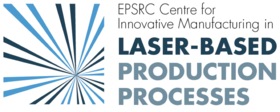 © EPSRC Centre for Innovative Manufacturing in Laser-Based Production Processes
© EPSRC Centre for Innovative Manufacturing in Laser-Based Production Processes
Centre Director: Prof. Duncan Hand, Tel: +44 (0)131 451 3020 | contact details | disclaimer
Heriot-Watt University, Edinburgh, Scotland - Scottish registered charity number: SC000278
































